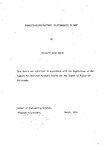PROPERTY-MICROSTRUCTURAL RELATIONSHIPS IN GFRP
| dc.contributor.author | Guild, Felicity Jean | |
| dc.contributor.other | School of Engineering, Computing and Mathematics | en_US |
| dc.date.accessioned | 2013-02-11T12:03:38Z | |
| dc.date.available | 2013-02-11T12:03:38Z | |
| dc.date.issued | 1978 | |
| dc.identifier | Not available | en_US |
| dc.identifier.uri | http://hdl.handle.net/10026.1/1298 | |
| dc.description | Merged with duplicate record 10026.1/2347 on 14.02.2017 by CS (TIS) | |
| dc.description.abstract |
This work consists of an investigation into the microstructure and mechanical behaviour of glass fibre reinforced polyester resin beams. The volume fraction occupied by glass fibres was 20-30%, which is that typically used in boat building. The beams tested were all unidirectional, with fibres oriented parallel or perpendicular to the long axis of the beam. Various techniques have been developed which may be applicable to other composite materials. The microstructure of the beams was investigated by observation of cross-sections using a Quantimet 720 Image Analysing Computer. Volume fractions and the distribution. of fibre cross-sectional areas were measured. Methods have been developed for the quantitative definition of the microstructure, in terms of the fibre arrangement. Cracks were grown in four-point flexural loading while monitoring acoustic emission. The acoustic emission circuit was built in the laboratory, and designed to monitor fibre failures only, one count being associated with one fibre failure. The processes of crack growth were further investigated by observation of fracture surfaces using a scanning electron microscope and measurement of crack profiles. The factors controlling the processes of crack growth have been elucidated. The material condition was monitored by specific damping capacity measurements. A free-free rig with excitation at the ends of the beam was developed. In addition measurements were made using a cantilever rig. Simple analyses involving the solution of the classical wave equation were carried out; a receptance analysis was also developed which allows the undamaged and cracked portions of the beam to be separated in the analysis. Invisible cracks, which had been indicated by acoustic emission, were successfully detected in both rigs. The correlation between recorded acoustic emissions and specific damping capacity measurements supports the validity of both techniques. Some correlation between properties and measured microstructures has been obtained here. These quantitative methods for the measurement of the microstructure of composite materials should prove very useful in a wide range of applications. | en_US |
| dc.language.iso | en | en_US |
| dc.publisher | University of Plymouth | en_US |
| dc.title | PROPERTY-MICROSTRUCTURAL RELATIONSHIPS IN GFRP | en_US |
| dc.type | Thesis | |
| plymouth.version | Full version | en_US |
| dc.identifier.doi | http://dx.doi.org/10.24382/4923 | |
| dc.identifier.doi | http://dx.doi.org/10.24382/4923 |
Files in this item
This item appears in the following Collection(s)
-
01 Research Theses Main Collection
Research Theses Main


